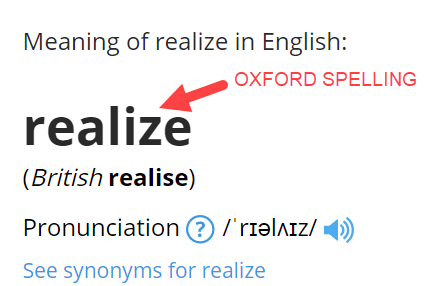
Proofreading Tips: What Is Oxford Spelling?
As a proofreader, you might come across the term Oxford spelling. But what does this mean? And how should you approach a document if your client specifies using it? In this post, we explain everything you need to know to proofread documents effectively.
What Is Oxford Spelling?
“Oxford spelling” is so called because it reflects the spelling style used by the Oxford University Press (OUP). In practice, though, it is essentially a version of British English that uses “z” spellings for “‑ize” suffixes (e.g., organize, organization, organized, organizers).
More specifically, when there is more than one way to spell a word, Oxford spelling favors the spelling closest to the word’s etymological roots. In most cases, this follows standard British English conventions (e.g., archaeology instead of the US English spelling archeology). But there are a few cases where the older spelling isn’t the one most associated with British English.
The clearest example is “‑ize” words, where the “z” spelling is closer to the original Greek. The “‑ise” spellings, on the other hand, come from a later French influence on English.
However, it can affect other words, too. For instance, Oxford spelling favors “yogurt” over “yoghurt” because the original Turkish word it came from does not have an “h.” This rogue “h” simply appeared because of how Arabic words were transcribed at the time.
What You Need to Know
The most important thing to remember is to use British English spelling conventions, but with “‑ize” suffixes in words like “organize,” “realize,” and “monetize.” However, there are a few subtleties to this system that you might want to be aware of:
- Some “‑ise” words are always spelled with an “s,” even under Oxford spelling rules or in US English (e.g., advertise, advise, chastise, comprise, disguise, revise, surprise).
- Words with “‑yse” suffixes keep the “s” spelling, unlike in American English (e.g., paralyse is correct in Oxford spelling, but it would be paralyze in US English). This is because the Greek root of this suffix was also spelled with an “s,” not a “z.”
- As noted above, this spelling style also affects some other words, like “yogurt.” This is rare, but you may want to check any unusual spellings you see before correcting them.
If you’re not sure which spelling to use for a term, check a dictionary that uses Oxford spelling. The best choice here is the Oxford English Dictionary (OED) given that it is published by the OUP. But for alternative options (without a subscription fee), you can try online dictionaries that use this approach to spelling, such as the Cambridge Dictionary or the Lexico website.
These dictionaries will have both “z” and “s” spellings for many words. But when this happens, the main entry (i.e., the top spelling on the page) will be the “Oxford” spelling.
When Should I Use Oxford Spelling?
As mentioned above, the OUP uses Oxford spelling in all of its publications. Thus, if you’re ever working on something published by the OUP, you’ll need to keep the rules above in mind.
Likewise, many other publishers and publications have adopted this spelling style, including the scientific journal Nature, Encyclopædia Britannica, and Cambridge University Press.
However, Oxford spelling is also considered an international form of English. As a result, many international organizations use it, including the United Nations, the World Trade Organization, NATO, Interpol, the Worldwide Fund for Nature, the Red Cross, and Amnesty International.Consequently, you should always check your client’s instructions on this count. International clients and publishers may well ask you to use “Oxford” conventions.
How to Become a Proofreader
For more on how to approach spelling and style as a proofreader, our Becoming A Proofreader course has you covered. Sign up for a free trial today to find out how it works.



Leave a Comment
Your email address will not be published.